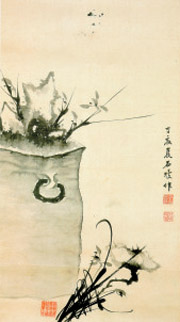The search for beauty in times of war

An oil painting of orchids by Yi Ha-eung, and “Wolhajukrimdo” by Kim Kyu-jin. Provided by the organizer
The current exhibition at the Hakgojae Gallery in Jongno, central Seoul, is a sample of works that bloomed during the Japanese colonial rule and political turmoil in the early 20th century.
Titled “Korean Modern Paintings and Calligraphies,” the display comprises 119 paintings and writings by 37 modern artists and scholars.
Most are elaborate paintings of sagunja, a traditional art that depicts four plants - the plum, orchid, chrysanthemum and bamboo. There are also landscape paintings of flowers and birds and calligraphic works.

Byungrando
Art is also a useful document of history, according to Lee.
Unfortunately, however, there have been few in-depth studies on modern Korean paintings due to a lack of resources.
“But many modern works are still highly valued and meaningful,” Lee said.
The paintings in the exhibition come from the personal collection of Woo Chan-kyu, the head of Hakgojae Gallery.
Woo has visited Japan numerous times over the past 10 years, buying the paintings and calligraphy from Japanese art collectors and galleries.
Many artworks were taken out of Korea during the colonial period. To date, Woo has brought back around 500 works.
One of the highlights are the oil paintings of orchids by Yi Ha-eung (1820-1898).
Yi Ha-eung (1821-1898), the father of King Gojong (1852-1919), better known as Heungseon Daewongun, was fond of painting orchids.
A must-see is “Byungrando” (1887), an oil painting on silk. Yi uses light brushstrokes to draw an orchid plant in new bloom from a pot.
The story goes that Yi drew the painting when he was kidnapped by the Qing Dynasty forces during an army rebellion in 1882. Painting orchids was Yi’s way of coping with political struggles.
“Wolhajukrimdo” (early 20th century), a dynamic 10-fold screen by Kim Kyu-jin (1868-1933), is also on display. Kim, a noted bamboo painter, used ink to draw a night landscape with a full moon and bamboo.
“Korean Modern Paintings and Calligraphies” runs until Jan. 24. To get to Hakgojae Gallery, take Anguk subway station, line No. 3, exit 1. For more information, call (02) 720-1524 or visit www.hakgojae.com.
By Lee Eun-joo Staff Reporter [angie@joongang.co.kr]










with the Korea JoongAng Daily
To write comments, please log in to one of the accounts.
Standards Board Policy (0/250자)